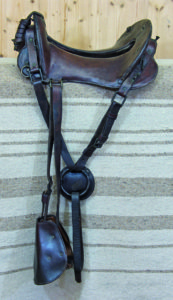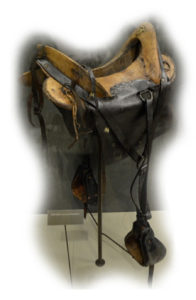Saddle Fit and All We have Seemingly Forgotten Over the Years… (A short history of design)
 Our forefathers depended on the soundness of the horse in order to be able to continue to do their jobs, or even survive. Horses at the turn of the century (and up to the mid-1900s) were still used primarily as working animals in agriculture or in the military. Their owners and riders were true horsemen, and generally knew everything they needed to know to keep their horses sound and their saddles and tack fitting well. Then when the industrial revolution really took off and horses were relegated to the sidelines, it seems that a lot of this knowledge and experience was simply lost in translation. It was not until the mid-1950s that equestrianism as a recreational and competitive sport began to really take hold – with a huge shift in demographics to the female side of the population. Unfortunately, although there are certainly still many true ‘equestriennes’ out there, many of today’s riders are women who are just now taking up the sport (having time and discretionary funds to spare for this not-inexpensive pastime) really have never had the advantage of being raised with horses, and need to rely on industry professionals to keep their horses happy.
Our forefathers depended on the soundness of the horse in order to be able to continue to do their jobs, or even survive. Horses at the turn of the century (and up to the mid-1900s) were still used primarily as working animals in agriculture or in the military. Their owners and riders were true horsemen, and generally knew everything they needed to know to keep their horses sound and their saddles and tack fitting well. Then when the industrial revolution really took off and horses were relegated to the sidelines, it seems that a lot of this knowledge and experience was simply lost in translation. It was not until the mid-1950s that equestrianism as a recreational and competitive sport began to really take hold – with a huge shift in demographics to the female side of the population. Unfortunately, although there are certainly still many true ‘equestriennes’ out there, many of today’s riders are women who are just now taking up the sport (having time and discretionary funds to spare for this not-inexpensive pastime) really have never had the advantage of being raised with horses, and need to rely on industry professionals to keep their horses happy.
One of the most glaring changes has been in the design of the saddle. Many of you will be familiar (at least in theory) with the McClellan saddle from Civil War days. This saddle epitomizes how much time and effort went into the design of military saddles, with a goal to produce a properly fitting saddle that would keep horses healthy for the longest time. McClellan studied and documented the design, construction, and innovative features of saddles from various European countries, and watched how the cavalries in several military conflicts used these. Based on his observations and analyses in Europe, he then developed a specific design for the US Army, which at the time was almost certainly the ultimate in saddle-tree innovation. It was used for the time during the Civil War in 1859, and was built for the last time in 1928. It was still in use during the Second World War, and is the basis for the design and development of the saddles used by many endurance riders today. What makes it so good?
The saddle allows for shoulder relief to accommodate the movement of the horse’s shoulders when in motion. The v-billet system is adjustable to ensure that the saddle will not bridge; it has a wide gullet, and it has a cut-out in the middle of the tree (which we have incorporated into our saddle designs as the patented Crotch Comfort® system). These are all great features with necessary benefits to the horse, and it is definitely not necessary to reinvent the wheel to design a saddle that is ergonomically friendly to horse and rider
Many of the latest ‘innovations’ in saddle design have actually found their origins in history, but much of this ‘common knowledge’ has been lost over the years. Saddlery is not a new science; saddles have been around and in use for many centuries. Especially in the cavalry it was crucial for the soldier to have a rideable, healthy horse available for use over long distances. It used to be one of the jobs of the cavalry officer to teach his men how to make the necessary adjustments to their saddle to bring it back into balance after changes in their horses’s musculature or nutrition altered his conformation. In those days, many saddlers actually lived with their horses. Working with them on a daily basis allowed them to become so intimate that they intuitively came to know what was best for their horses. This knowledge was passed on through the generations, mostly from father to son. Most saddles were made on an individual, totally custom basis, beginning with the horse. The tree was made after the horse’s conformation was analyzed and measured; leather was cut accordingly, and the saddle was flocked as necessary to accommodate a specific horse’s back.
 This is still how saddles are made for working horses in Brazil by their owners – the cowboys.
This is still how saddles are made for working horses in Brazil by their owners – the cowboys.
In the 20th Century the recognition of the horse for recreational and athletic purposes opened the equestrian industry as a mainstream activity – which led to the rebirth of saddlery on a whole new level. Women began to ride astride on saddles which had been made for men, preferring their security over the traditional female side saddle. Saddle manufacturers jumped on the bandwagon and began mass production of generically fitting saddles (narrow, medium, wide, 16”-19”). Demand created the process and the business was driven by business people rather than knowledgeable saddlers and horse people. (It is interesting to note, that although the development of tanks, jeeps and artillery replaced the use of horses for the most part after the Second World War, the sport of 3-day eventing actually had its origins in the military. The first competitors were almost exclusively cavalry officers and to this day this sport is nicknamed “military” in Germany.
So as it turns out, a saddle that was originally conceptualized for military used is nowadays responsible to ensure fun and adventure rather than used in place of fear and conflict. Times may have changed, but the health and comfort of horse and rider still need to be the focus of saddle fit. More manufacturers ought to look to the origins of especially the McClellan in their design; sometimes too much focus is put on ‘looks’ rather than functionality and purpose.
